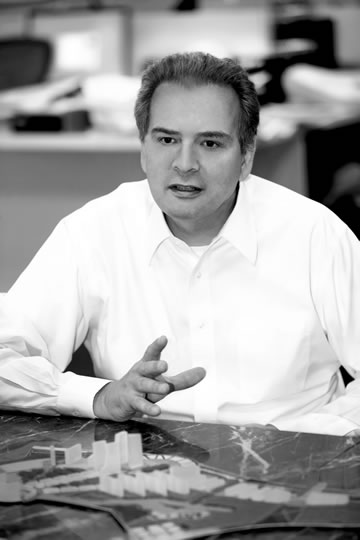Gordon Beckman’s interest in high-rise buildings started when he was 12 years old. Along with several of his neighborhood friends in Rockford, IL, he decided to construct a tree house. It started with modest dimensions, but “pretty soon, it was a five-story tree house that went well above the telephone wires,” says Beckman, AIA, principal and design director at John Portman & Associates in Atlanta. He says the project even attracted enough attention to make the local news.
 Now, more than 40 years later, Beckman has experience working nationally and internationally, designing U.S. projects like HALO Corporate Headquarters in Niles, IL, and New Music City Convention Center Hotel in Nashville, TN, along with global projects like China Center. And he says he’s still having just as much fun as when he built his first tree house.
Now, more than 40 years later, Beckman has experience working nationally and internationally, designing U.S. projects like HALO Corporate Headquarters in Niles, IL, and New Music City Convention Center Hotel in Nashville, TN, along with global projects like China Center. And he says he’s still having just as much fun as when he built his first tree house.
Q: How did you get started in high-rise architecture?
A: When I was 15 years old, I started working for the first architect I ever worked for; I’m now 57, and I’ve worked with architects or as an architect ever since. So I’ve never had a job outside of this profession. I graduated from the University of Wisconsin in 1980 with my master’s degree, and gave a presentation that was seen by someone at Murphy/Jahn’s office. Two days later, I got a phone call and they asked me to work for them. That exposed me to a great deal of work in Europe, and what started to fascinate me was the different technology being used all over the world. I also joined Kahler Slater Engberg in Milwaukee, WI, and Larson and Darby in Rockford, IL. I tried to craft my career around the ability to work in all the corners of the globe and understand the technologies and ideas being used in other places that can be applied here in the United States – and vice versa. What I’ve always done is something I learned from my mother: No matter what you do, just have fun. To this day, I can honestly say I’m still having fun with what I do.
Q: What trends do you see right now within the industry?
A: One of my big concerns – with tall buildings especially – is that we spend an awful lot of time thinking about what’s over our heads. But we don’t spend a lot of time thinking about the city the building is being built within, or the layer that we live in. You have to think about the object, but you also have to think about the ways in which people live and interact with each object on an urban scale, at the building scale, and at the details scale. I went to school for a year in London and a year in Paris, and I always go back to an idea from there: What draws you to these places and makes these places special isn’t necessarily the buildings themselves (with some exceptions), but it’s the spaces between the buildings. So I’m interested in how we integrate these high-rise buildings into the city in such a way so that they’re not just objects on every block. If you look at New York City, everyone basically owns a block and then puts their big object on that block. In European cities, it’s the other way around: The blocks are unified in huge sections, and in those sections become icons.
Q: What challenges does high-rise architecture pose?
A: A big issue today with tall buildings is that, in every RFP we get from every company, developer, organization, or group, there’s always a paragraph stating that the building should be “iconic.” So you start to see buildings of extreme forms, with wavy façades or something to distinguish them from the building next door. But when you look at them on a city skyline as a whole, they merge into one. I think it’s almost gotten to the point where the most iconic building you can build today is a square box; it will stand out from all those other buildings that are trying to call attention to themselves.
Q: How do you balance the creation of iconic structures that clients want with functional design that also fits well within a geographic location?
A: I think we first try to find the essence of the project and of the urban idea, even with tall buildings. And then we think about how the building can serve as a special place, and how that placemaking can become just as iconic – or even more iconic – than the actual building itself. If you think about the buildings people categorize as “iconic,” you think about the Eiffel Tower or the Washington Monument. These buildings have no functional use – they’re icons because of their form, and they’re icons because they’re special, unique pieces within an urban environment.
Q: How does this idea of “iconic” buildings play into facilities management?
A: Building uniqueness can originate with an idea about how a building meets the ground, how the core of the building can work in a more powerful way to facilitate the people using the space, or with an idea about energy, comfort, or sustainability. If that “iconic” quality comes out of something very real and tangible, and also adds value, then it’s a much stronger idea.
Q: Do you have any words of wisdom to share based on your experiences with high-rise facilities?
A: Mistakes are okay – they only mean that you have to learn something a little bit better. But sometimes you can get too involved, so you have to learn to be somewhat self-critical. Just because you can draw it doesn’t mean that it’s the right thing to do. We’re custodians of our urban environment in a sense, and we need to take care of these places where people live.
Leah Grout Garris
 An award winning editor, Leah spent over eight years in senior
editorial positions at both BUILDINGS magazine and ARCHI-TECH
magazine. Her work has been incorporated into training and
educational programs around the country. She is a graduate of
University of Iowa. She is Editor at Large for High Rise Facilities.
An award winning editor, Leah spent over eight years in senior
editorial positions at both BUILDINGS magazine and ARCHI-TECH
magazine. Her work has been incorporated into training and
educational programs around the country. She is a graduate of
University of Iowa. She is Editor at Large for High Rise Facilities.

